Forgotten Buildings Heritage Walk (original) (raw)
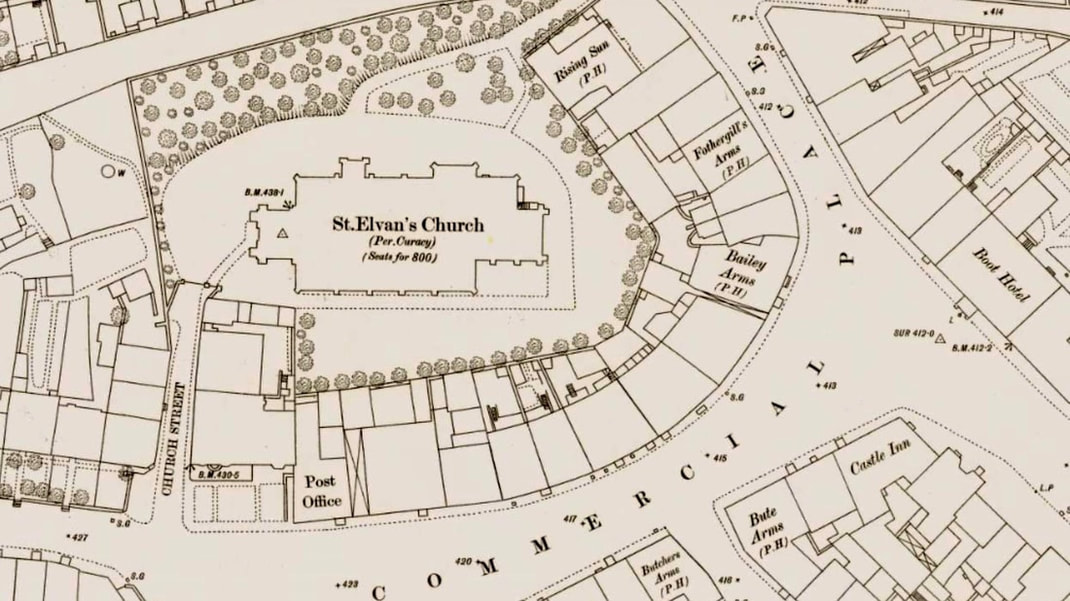
This walk has been created to bring back to life the some of the fine buildings that once graced the Aberdare Town Centre but have since disappeared and forgotten about. It starts and finishes at St Elvan's Church and is easy walking within the main town centre area. The walk should take about one hour. A route map accompanies the walk and care should be taken as it involves crossing some busy town centre roads. If you are not local to the area this walk would be unsuitable. From time to time the walk will be led by a guide otherwise it can be self-guided and is available to to view online below or to download as a PDF to print via the link below
Start at St.Elvan's church
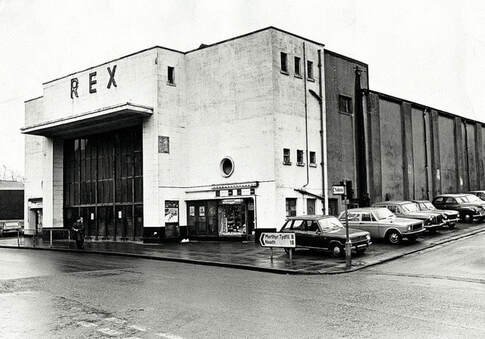
Leave St Elvan’s churchyard and walk down to the corner of the junction with High Street
Today, High Street hardly exists, except as a thoroughfare. In the 19th Century it was one of the most important streets in Aberdare connecting the old village centre around the Parish Church to the old parish road that ran through Wind Street and the main route down the valley
The car park besides us was once the site of the Rex Cinema, opened on 10th April 1939 by W.E. Willis
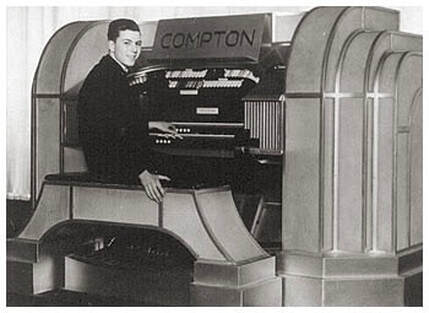
Willis named the cinema after his son Rex Willis, the Welsh International Rugby Union fly half in the early 1950's . The Cinema was decorated in Art Deco style was one of the finest in South Wales with seating for 1250 and was equipped with a rare Compton Theatrone organ that rose on a lift from below the stage with coloured lights
At its opening the organ was played by Max Bruce who was the first organist at the Tower Ballroom, Blackpool in 1929 just before the famous Reginald Dixon
The cinema finally closed its doors on 6th July 1983 In 1985 the Welsh Language comedy film ‘Coming up Roses” was filmed there. It was demolished in the 1990
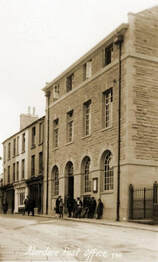
As we walk west along High Street, we pass a splendid building that was once the town’s main General Post Office built in 1925 from Forest of Dean stone. Previously it was the site of the original Boot Hotel., when high street was the old parish road. It is now a Wetherspoons pub bearing the name Ieuan ap Iago (the bardic name for Evan James)
It was however supposed to be named after his son James James, composer of the Welsh National Anthem who we would normally associate with Pontypridd where he and his father both lived and worked. James James did however move to Aberdare in later life, living at 6 Hawthorne Terrace Aberdare, he died in 1902 and is buried at Aberdare Cemetery. There is a small monument at the
corner of High Street
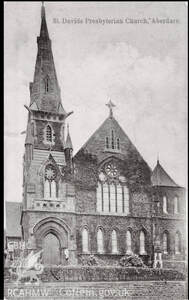
The building next door to Wetherspoons wasSt. David’s Presbyterian Chapel . Built in 1877 and rebuilt in 1899 for English Presbyterians following a split from Trinity Chapel, with seating for 400. It once had a splendid 85ft steeple and was designed by W. Douglas Blessley, (who also designed the Prince of Wales theatre and Great Western Hotel in Cardiff). It closed in 1952 and the steeple taken down in 1960. It has gone through several changes of use over the years, it was once the main Aberdare Telephone Exchange, a mental health unit and now a gym, the front elevation however remains largely unaltered
As we progress down High Street the adjoining roadway leads to the Rock Grounds
The present building of 1938 was once a Clinic, then council offices and was once adjoined by the Rock Outdoor Baths
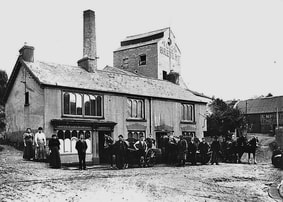
The grounds are named after the Rock Brewery which stood on the site. It was one of several breweries throughout the town in the Nineteenth Century
A brewery has stood on the site since around 1850
By 1871, it had 19 tied public houses across the town. When it was sold to Allsopps in 1921 it had over 40
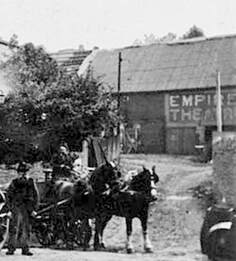
In the 1890s the brewery owners at the time Morgan Richard David of the Grange Aberaman laid out recreation grounds to the right of the building to include a circus and what became the long-forgotten Empire Theatre
Living pictures were first seen in Aberdare here in September 1896 and exhibited at the through the new Harvard’s Cinematograph
The following year an audience watched animated pictures of Queen Victoria’s Diamond jubilee procession
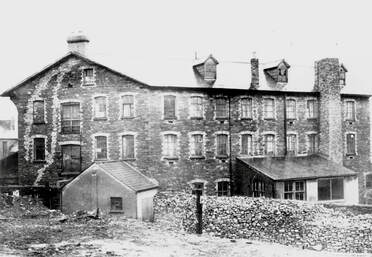
As we continue our walk the area to the right of the BT Exchange was once the Glandare Woollen Mill. It is likely it stood over an uncovered River Dare, manufacturing Welsh Flannels with a front onto 28 Canon Street
It was sold to Peter Halewood and became
Halewood’s Boot & Shoe factory in 1895 and was one of the largest makers of footwear, with branches throughout South Wales and many branches in the valley
The mill closed in the 1920s
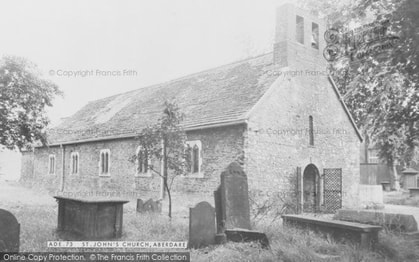
We continue our walk through Library Square towards St John's church, passing by the new Library built in 1962
This area was originally the oldest inhabited part of Aberdare and the original village and village green (Green Fach) in 1841 Green Fach was the most densely populated part of Aberdare. Passing the large building that is now Bradley’s but which was the once the original market house and our Town Hall, and passing by Green Street English Wesleyan Methodist chapel built in 1859 and enter through the car park to St John the Baptist parish church
St John the Baptist is the original Parish Church of Aberdare and was estimated to be built in 1189 and is of Norman design, making it the oldest building in Aberdare by some 600 years. The church as it stands today is not radically altered from the original medieval building. The church would have been the focal point of the old village. A few original architectural features remain which you should visit at another time, such as the Sutton stone doorway in the vestry, which was the original entrance and the octagonal font carved in Sutton stone
The graveyard you will find of particular interest the graves of prominent families of the industrial age are buried here; such as the Wayne family who owned Gadlys Ironworks, the Morgan family of Gadlys, the Roberts family after which Robertstown was named, David Davis of Blaengwawr after which Davistown was named. The oldest recorded gravestone bears the date of 1688
There are two gravestones to point out near the West of the entrance is the grave of Gwenllian (Rhys-Jones) first wife of Caradog (1879), his father John Jones (1847) and his grandparents. Caradog himself is buried at Aberdare Cemetery. The other gravestone to note is that of Philip Rees, builder of the town from Graig House, Monk Street, who built many fine buildings in the town including St Mair’s Church and the Temperance Hall
On the South Wall of the church is a sundial from 1760, which worked until it was vandalised in the 1930’s
Standing outside the main church entrance and look up the West wall to the bellcote the left-hand bell is the ancient “Matthew Bell”, the inscription on the bell on the bell shows it was presented as a gift by William Matthew of the Aberaman estate in 1637 and is one of the oldest artefacts in the town. The bell was cast by John Palmer of Gloucester. There is some mystery however as old photos of the Church clearly show only one bell in the righthand bellcote, it is uncertain what happened to the other bell. Today however we see two bells, the Matthew bell being moved to the left-hand side and the bell from St Johns the Evangelist, Roberstown moved to the righthand side in the 1980’s and is used today
Walk through the churchyard to the North entrance glancing at the south wall you will see the old metal remains of the horse ties
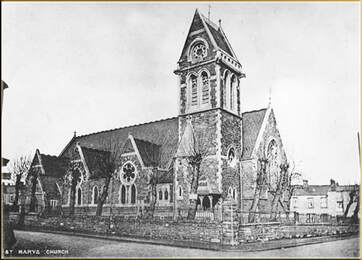
At the North Entrance look across the road to where 'Cynon Linc' now stands, this was once the site of the beautiful church of St Mary the Virgin, commonly known as St Mair . The Welsh speaking church was built in 1864. as St John's had insufficient capacity for the Welsh Congregation
Dwindling numbers and financial pressures in the 1960s saw it sold to Aberdare District Council in 1963 for £2500 and later demolished in 1965. Many of the fittings and stained-glass windows were however saved and transferred to St Mathew’s and St Elvan’s churches were they can be seen today
The church was designed by London architect Arthur W Bloomfield, who was assisted by his junior architect the famous novelist Thomas Hardy. It is said that Hardy visited Aberdare on a regular basis to oversee the work. It was reported that he stayed in Monk Street, probably with Philip Rees of Graig House during its building
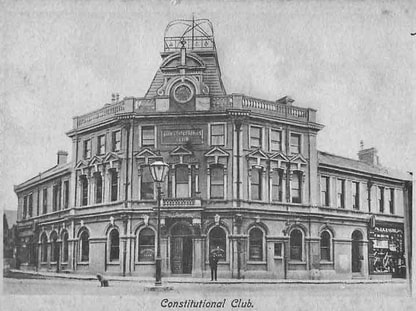
As we return to Canon Street this represents the formal development on land owned by the Diocese of Gloucester and laid out in 1854. We look across to the impressive building on the corner which is the Constitutional Club opened in 1894 and became an important place of entertainment for the town. It once housed an Edwardian Music Hall the Palace Theatre of Varieties (1909) Later re-named the New Empire Theatre and Cinema. In later years it became GoGo’s disco and then a clubAs we return to Canon Street this represents the formal development on land owned by the Diocese of Gloucester and laid out in 1854
We look across to t
he impressive building on the corner which is the Constitutional Club opened in 1894 and became an important place of entertainment for the town. It once housed an Edwardian Music Hall the Palace Theatre of Varieties (1909) Later re-named the New Empire Theatre and Cinema. In later years it became GoGo’s disco and then a club
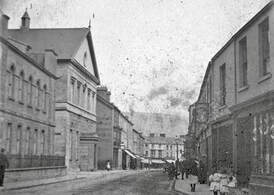
Walking down Canon Street the stone building on the right is the Masonic Hall and on the left is Trinity Presbyterian Chapel opened in 1867
We however turn our attention to the large convenience store and flats. This was once the now demolished and forgotten Temperance Hall built in 1858 by Aberdare builder Philip Rees and funded to the cost of £3000 by the Total Abstinence Society. It served as the town’s main public hall and theatre with seating for 1200 for many years
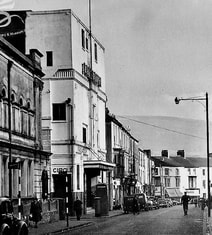
It was later named the New Theatre and HippodromeBy 1918, the building then had new owners and was re-named the Palladium CinemaBy the late 1920s it was given a more modern look, before finally closing in the early 1970s to become a bingo hall
The new building has reverted to its appearance as the Temperance Hall
Walk to the junction with Whitcombe Street the outfitters that was once the Queens Hotel (1861-1923)
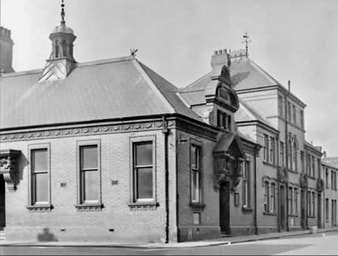
Walk along Whitcombe Street to junction with Seymour Street, entering Maesydre the names reflect the previous ownership of the land by Dean and Chapter of Gloucester. Stopping at the junction with Seymour Street where the block of flats now stands was the oldMemorial Hall
The Memorial Hall and church club was a memorial to the Reverend Richard Bowen Jenkins, Vicar of Aberdare and was opened on the 29 June 1895 and paid for by public subscription of £3,296, the building was beautifully decorated with terra cotta mouldings with two entrances
The church club contained a reading room, card rooms and Billiard room, splendid gymnasium. The Club was also the first home of the Aberdare Public Library opening in 1904. Throughout the 1950’s and 1960s it was a dance hall and club. It was demolished in 1988
Retrace your steps back to Canon Street and walk to Market Street
While walking through Canon Street you’ll pass by the Lloyds Bank building which was originally the old Caradog Arms. It had close connections with St Elvn’s through the then the Old Brecon and Wilkins Bank, managers Leonard Acomb became parish warden and Thomas Bowes Powell donated the brass eagle lectern seen at St. Elvan’s, before continuing to walk to Market Street
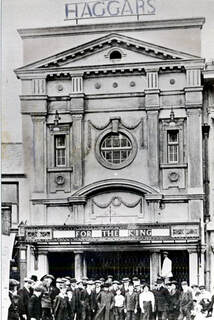
Market Street was the site of the original market hall complex built in 1853, the very first National Eisteddfod of the modern era took place there. What is now the car park at the side of the Market Hall was throughout the nineteenth century a cattle yard and was also the venue for travelling theatres and shows
It was here that film pioneer William Haggar who toured South Wales with a portable bioscope in 1904 set up a permanent booth there (Haggar’s Royal Electric Bioscope and later Coliseum). In 1914 he purchased the freehold of the drill hall opposite his market yard pitch in order to build a purpose-built cinema, The Kosy Kinema (now the Betting Shop) a handsome building with folding seats for 700
The cinema was taken over by Willis in 1933 and renamed the Cosy Cinema, it was badly damaged by fire in June 1946 and forced to close and never rebuilt
Before leaving market street take a quick look at another fine building built in a classical style in 1914 as the new Magistrates Court, the date of the building is shown as Roman numerals.
Return to Cardiff Street Cardiff Street lay on Bute land and was probably established as a new turnpike route into the town and was probably built to supersede the old parish road through Wind Street
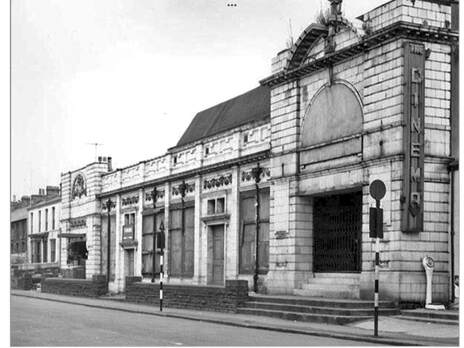
Cardiff Street
Walk East to the junction with Cross Street stopping near Argos
Just to the left of the Copper Kettle shop was the Aberdare Electric Cinema, the first permanent purpose-built picture house opened in 1912, three years before Haggar’s cinemas, and with seats for 900 operated by V W Rowe. It was famous for its tiled frontage that ran longitudinally along Cardiff Street. Many local people used to say that it looked more like a swimming bath than a cinema. It was equipped in the 1930’s when a Picturetone system was installed. It closed in around 1959 and demolished. It was replaced by the Coop food store and Madeley’s DIY
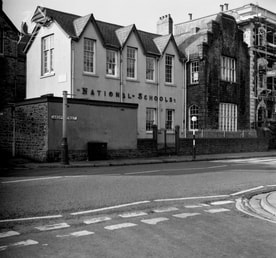
As we look across the road of Cardiff Street with Cross Street was the old National School
The National School for Boys and Girls was built in around 1829 through The National Society for Promoting the Education of the Poor in Principles of the Established Church (1811) by Dr Andrew Bell. Pupils in the National School were taught the Church Catechism and Creeds, with children expected in Church on Sundays. The land was donated by the Marquis of Bute. In 1847 the school had 100 boys and 60 girls
In 1975 the school closed and moved to the Mardy School to become Town Church
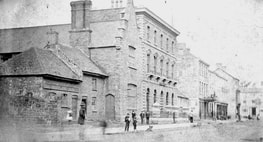
Next door to the school is the now closed HSBC bank
It was opened in January 1858 by The West of England and South Wales District Banking CompanyBy 1880 The West of England Bank had been replaced by the National Bank of Wales later the Midland
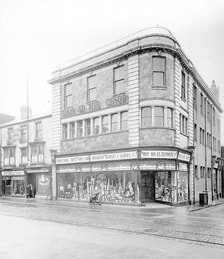
Retrace our steps along Cardiff Street back to Victoria Square
As we walk back to Victoria Square we would pass along where the **Aberdare co-operative society flagship store had stood in Cardiff Street since 1869
Fire destroyed the original store in 1919
The store was then rebuilt in the 1930s occupying the corner position and the image opposite shows that store as it looked in the 1930s
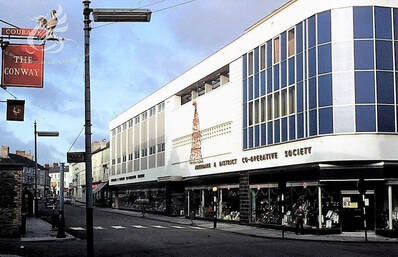
The store was then extended and completely modernised again in 1965
It once dominated the town centre scene and sold everything from furniture to hardware
The building was demolished in 1995
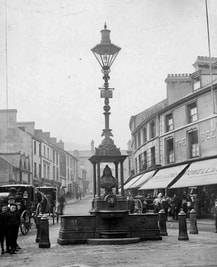
Victoria Square
The area of Victoria square was formerly known as Commercial Place and was developed on Bute Estate land. It was renamed as part of the Queen Victoria Jubilee celebrations
Where the Cenotaph now stands once stood the Jubilee Fountain, it was donated by W T Lewis to commemorate the Diamond Jubilee of Queen Victoria. The fountain was officially dedicated on 18th November 1897. The cast iron structure manufactured by Coalbrookdale iron company. It was probably destroyed during the second World war as raw material for the war effort
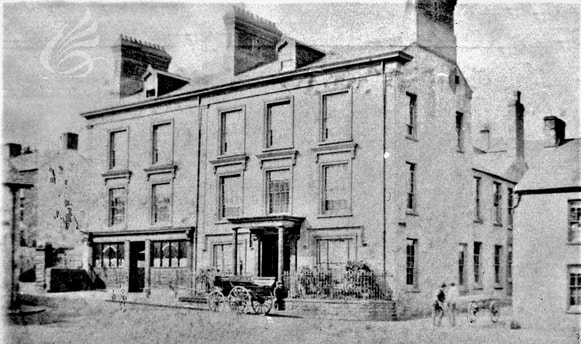
Walk to the top of Victoria Square
The square, which still retains its Victorian character, was dominated at each end by the former Boot and Black Lion Hotels. The earliest Black Lion was opened in 1811 as an old coaching inn on the old parish road, it housed the town’s first mail office and was a posting house in 1828 and a Brewery
As we return to St Elvan’s we see the Square being dominated by the statue of Caradog (Griffith Rhys Jones),the statue was erected in 1920 and designed by Sir William Goscombe John, to celebrate the famous South Wales Choral win at Crystal Palace in 1872 and 1873
For information on the annual Caradogfest choral festival held in the town each year in mid July, visit www.caradogfest.com
Return to St Elvan’s to conclude the walk and visit Spires Coffee shop for a well earned coffee! Thank you for participating in our Forgotten Buildings Heritage Tour